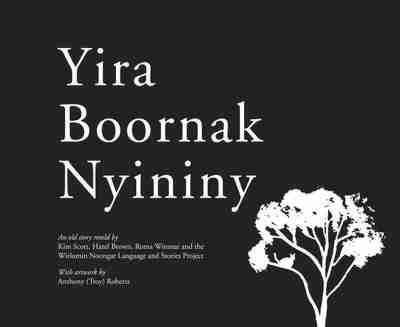A man is tricked by a woman into climbing into a tree after a possum by using a piece of timber as a ladder. She then removes the timber and runs off with his nephew. He is then left in the tree and is starving when a farmer hears him calling while he’s out looking for his sheep. The farmer nurses him until he is well again – and the starving man says, ‘You’re my brother’.
Each double spread has text on one side and a full colour painting on the right. Anthony Roberts is a relative of Geoffrey Woods who illustrated another book in this series: ‘Noongar Mambara Bakitj’. Their style of painting is paint washes in brilliant colours reflecting the ochre of the land, the purple of the hills and the bright blue sky. The human figures of the story are painted as silhouettes in action the farmer is a white silhouette with a black hat on.
The text is in both Noongar language and two translations into English. The Noongar appears first, with literal English translation of each word or phrase underneath. This enables the reader of only English to feel the grammar and style of the original oral story eg ‘Yira boornak nyininy’ literally means ‘High tree of sitting’. The story as picture book text (to be read aloud in English) appears at the bottom of the page.
The American linguist Gerhardt Laves recorded stories told to him by Noongar men Bob Roberts and Freddie Winmer at Albany Western Australia in 1931. Laves’ family returned the stories to Australia with his papers, fifty years later. AIATSIS has guardianship of them and worked with the University of Western Australia to bring them back to the Roberts and Winmer families. Along with other community members, Kim Scott and extensively workshopped the stories as part of the Noongar Language and Stories Project over several years, resulting in six published picture books.
An essay at the back of the book has more detail about the development of the stories into published form, including workshopping in local schools. Readings of the book in both Noongar and English are available through the project’s website. A glossary is provided with this note: ‘We rely on the spelling conventions of the now defunct Noongar Language and Cultural Centre and Education Department of WA although dialect differences may make some of our choices unorthodox.’

